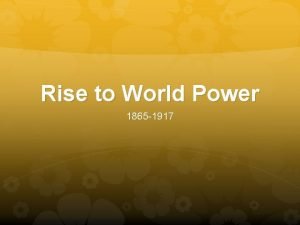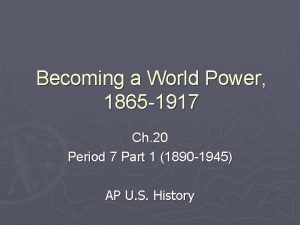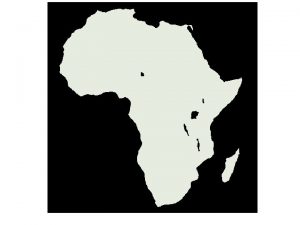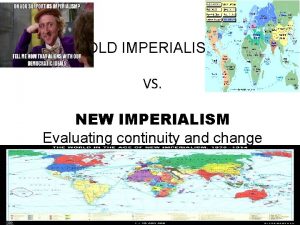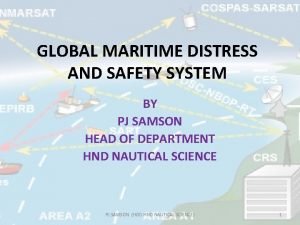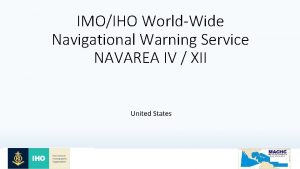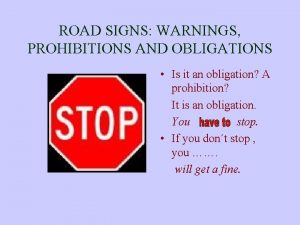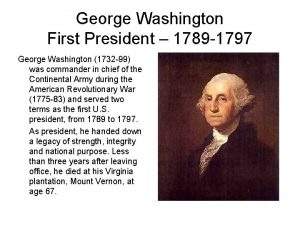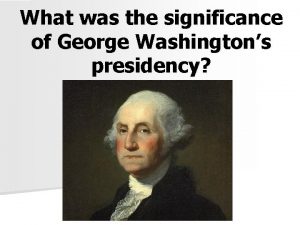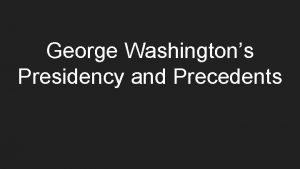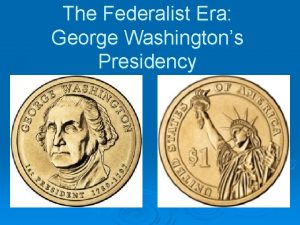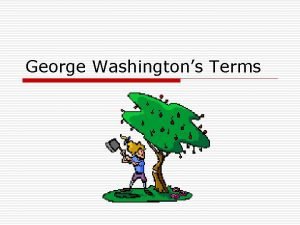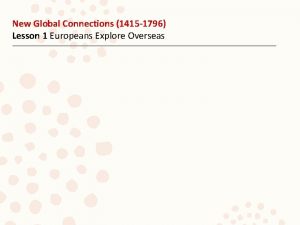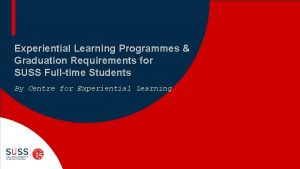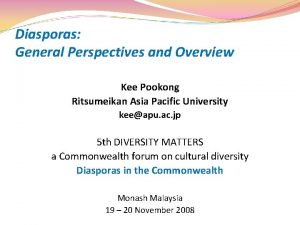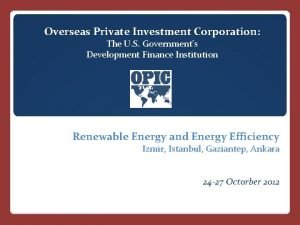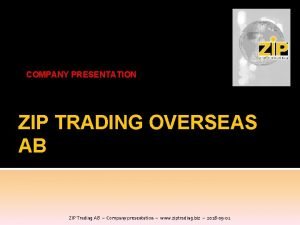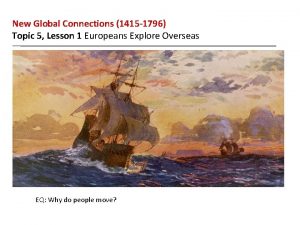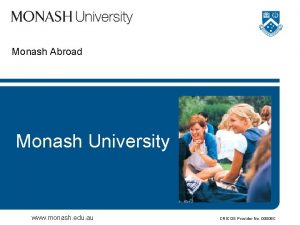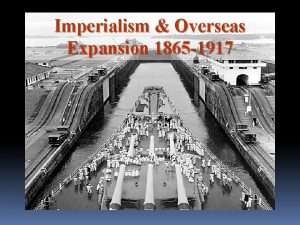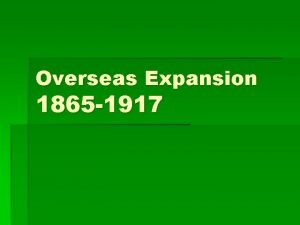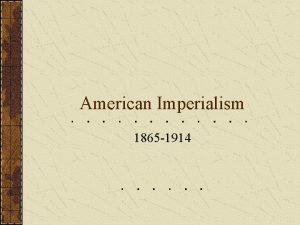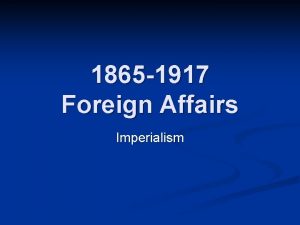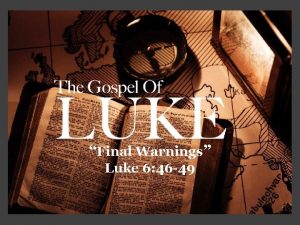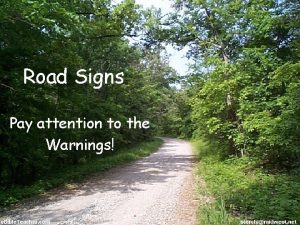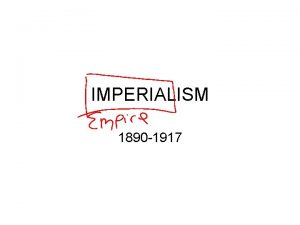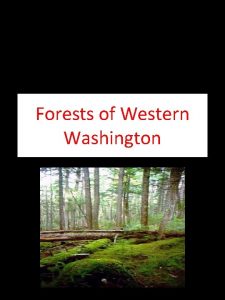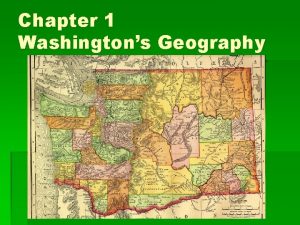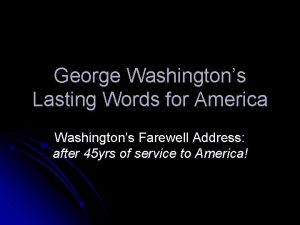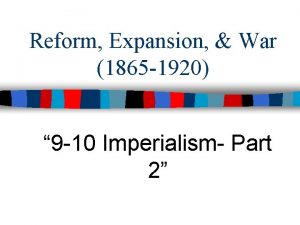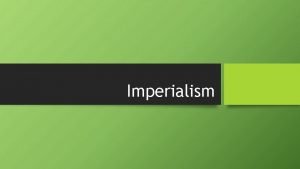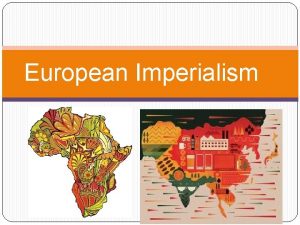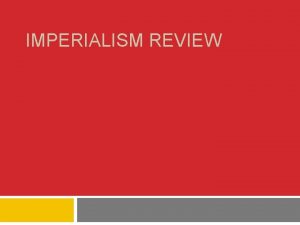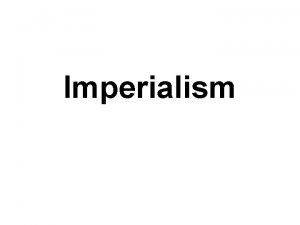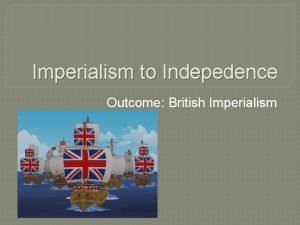Imperialism Overseas Expansion 1865 1917 Washingtons Warnings n




























- Slides: 28

Imperialism & Overseas Expansion 1865 -1917

Washington’s Warnings n Washington's Farwell Address guided American foreign policy for over 100 years: n ■ “… steer clear of permanent alliances with any portion of the foreign world. ” Some believed this policy meant the U. S. should be isolationist others pointed out Washington supported trade with other countries and was not calling for complete isolation in the world.

Manifest Destiny Achieved n In 1890, the nation had expanded from sea to sea. § § Lack of a frontier was alarming Began to look beyond America’s boarders (expansionism) expansionism for a new frontier with the goal of expanding trade and to compete for political influence.

Opening Japan n During the Mid-1800’s, American merchants made a great deal of money trading with China This led many to want to open trade with Japan, which had chosen to remain isolated from the West. 1853, President Millard Fillmore sent Commodore Mathew Perry on a mission to Japan to open trade.

Opening Japan n n Perry steamed into Tokyo Bay with four warships and asked the Japanese to open their ports to U. S. ships. Perry returned after several months and found America’s display of Naval force had convinced the Japanese to sign the Treaty of Kanagawa. n The treaty opened two ports to American ships and ended Japan’s isolationism from the West.

Imperialism ■ The 1900’s were called the age of imperialism ■ n a time when many European nations created large empires by obtaining economic and political control over weaker nations The search for raw materials and markets fueled imperialism European powers competed for power and influence in Asia and Africa.

American Imperialism n Secretary of State William H. Seward pictured an American empire that would dominate the Caribbean, Central America, and the Pacific. n n Central to maintaining this empire would be a canal across Central America that would link the Atlantic and Pacific Oceans. Seward purchased Alaska in 1867, from Russia for $7. 2 million a territory twice the size of Texas. Many newspapers and people criticized the purchase as a barren wasteland it was dubbed Seward’s Folly by his critics. After gold was discovered in the 1890’s (and later on oil and other resources) Seward’s Folly became a bargain

Building Sea Power

Captain Alfred Thayer Mahan n n He called for improving and enlarging the navy. He argued that sea power would protect shipping and provide access to world markets To maintain a powerful navy the U. S. would need overseas colonies where ships could be supplied and refueled. By the early 1900’s the U. S. had the naval power it needed to back up an expanded role in world affairs.

U. S. Imperialism in the Pacific n n Secretary of State William H. Seward believed the U. S. could build its empire in Hawaii through trade. In 1868, Seward acquired two small Pacific Islands of Midway as a stopping off point for American

U. S. Imperialism in the Pacific n n n The navy and merchant ships needed more than just these small islands to secure the Pacific. Hawaii would be a great port that would help secure the Pacific Christian missionaries had already arrived in Hawaii in the 1820’s. A large sugar plantation business had been established by merchants who brought in workers from Japan and China to work the land. Hawaiians led by Queen Liliuokalani tried to regain economic control from the Americans. U. S. diplomat John Stevens arranged for marines to assist an uprising and secure the

China and the Open Door

Rivalries in China n n For Americans the Pacific islands were a stepping stone to a larger prize, China was torn apart by internal fighting and lacked industry that made it too weak militarily to resist foreign powers who wanted to exploit its vast resources and markets By the late 1800’s Japan and the European powers had claimed spheres of influence in China where each country had special rights and powers U. S. leaders worried the country would be squeezed out of the profitable Chinese market

Rivalries in China n n Secretary of State John Hay proposed the Open Door Policy under which each foreign nation in China could trade freely in the other nations spheres of influence The foreign nations were not quick to agree to this policy that benefited the U. S. the most n n This soon changed in 1899, because a secret martial arts society known as the Boxers began a violent revolt to rid China of the “foreign devils” In August of 1900, foreign troops broke the siege and defeated the

The Spanish-American War

The Cuban Rebellion n n Cubans longed for their colonial ruler Spain to leave Spain defeated a Cuban rebellion forcing Jose Marti to flee to the U. S. to gather money, arms, and troops In 1895, Marti returned to Cuba and led a revolt Many people including Marti died. The rebels burned sugarcane fields hoping to get the Spaniards to leave

The Cuban Rebellion n n n The Spaniards retaliated by herding Cubans into reconcentration camps to separate them from the rebels Thousands died in the camps from starvation and disease The Cuban struggle got the attention of U. S. businessmen who wanted to protect their investments and trade with the island Others were afraid of rebellion so close to the U. S. President Grover Cleveland opposed U. S. intervention When William Mc. Kinley became President he too looked to keep the U. S. out of the war

Remember the Maine n n After rioting broke out in the Cuban Capital of Havana President Mc. Kinley sent the battleship Maine to protect American citizens and property After three weeks the ship exploded and sunk in Havana Harbor killing about 260 officers and crew American Newspapers blamed the Spanish and the slogan “Remember The Maine” became a rallying cry for revenge and war against Spain When negotiations failed to ease American concerns Congress

Yellow Journalism n n n By 1898 - Newspapers provided the major source of news in America Editor’s interpretation of news was often more commonly reported than the actual news To increase circulation, publishers often embellished headlines Known as Yellow Journalism Joseph Pulitzer and William Hearst worst offenders The two men used the practice of Yellow Journalism to help stir American public

Teddy Fights n Teddy Roosevelt during the Spanish American War n n Resigned position as secretary of navy, and became commander of the 1 st Regiment of the US Cavalry Volunteers Unit known as the Rough Riders

Teddy Fights n On July 1 st, the Rough Riders, along with African American soldiers joined the Battle of San Juan Hill n n n Assisted Americans in capturing San Juan Hill Helped to end the Spanish Resistance in Cuba Although fighting will be done in Cuba, fighting will continue in the Pacific

The Spanish American War in the Pacific Fighting in the Pacific centered around the Philippines n n Islands were Pacific base for Spanish Fleet US Commodore George Dewey launched a surprise attack on Spanish fleet in Manila Bay Continued fighting led to American victory U. S. gained control of the Philippines

“A Splendid Little War” n n Secretary of State John Hay called the Spanish American War “a splendid little war” The war lasted four months and 400 Americans died. More than 2000 additional died from tropical diseases like yellow fever and malaria African Americans faced discrimination and segregation in the military battling alongside the Cuban rebel army where black and white troops fought as equals

American Acquisitions n n n The U. S. and Spain signed The Treaty of Paris Dec. 10, 1898 marking an end to the war Cuba became a U. S. protectorate (an independent country under control of another country) Puerto Rico and Guam became territories of the U. S. Spain also surrendered the Philippines to the U. S. for $20 million (will remain an American territory through 1946!) In 1901, the U. S. granted Cuba independence but only if their new constitution included concessions to the U. S. known as the Platt Amendment The amendment prohibited Cuba from making treaties with other nations and gave America control of the U. S. naval base at Guantanamo Bay. The U. S. could also interfere in Cuban affairs if the countries independence was threatened

Latin American Policies n n The U. S. wished to build a canal across Central America to connect two oceans and newly acquired territories The French had a contract to build a canal in the Columbian province of Panama, an isthmus (a strip of land connecting two larger bodies of land) n n n The French had failed at building the canal and the U. S. bought the lease from the French for $40 million In 1903, Secretary Hays negotiated a treaty for a 99 year lease on the land in exchange for $10 million and an annual rent of $250, 000 Columbian opposition grew against the deal. This angered President Roosevelt He used the Big Stick Foreign policy to support Panamanian rebels in a revolt against Columbia and intervened against Columbia when they sent troops On Nov. 6, the U. S. recognized Panama’s independence and Hays signed a new treaty with the country of Panama Some members of Congress were angered by Roosevelt’s actions but Roosevelt replied: “I took the canal zone and let Congress debate”



Policing the Western Hemisphere Roosevelt Corollary • America has the right to act as “policeman” in Latin America. • To preserve American interests the U. S. would intervene reluctantly (economically • This policy was an addition to the Monroe Doctrine Dollar Diplomacy • While Roosevelt thought of American power in military terms his successor William Howard Taft took a different view • Taft wanted to alter American foreign policy by “substituting dollars for bullets” • Taft was willing to intervene in other nations when U. S. business interests were threatened • He believed American investments would bring stability to troubled areas of the world as well as profit and power to the U. S.
 Becoming a world power 1865-1917
Becoming a world power 1865-1917 Chapter 20 becoming a world power notes
Chapter 20 becoming a world power notes Africa 1890
Africa 1890 New imperialism vs old imperialism
New imperialism vs old imperialism Valproic acid warnings
Valproic acid warnings Escobedo v illinois
Escobedo v illinois Distress message format
Distress message format Navarea iv warnings
Navarea iv warnings Obligation road signs
Obligation road signs George washingtons phobias
George washingtons phobias Lesson quiz 9-1 the federalist era
Lesson quiz 9-1 the federalist era Washingtons presidency
Washingtons presidency Washingtons state tree
Washingtons state tree George washingtons precedents
George washingtons precedents George washingtons domestic policy
George washingtons domestic policy George washington phobia
George washington phobia Chapter 9 lesson 2 early challenges answers
Chapter 9 lesson 2 early challenges answers George washingtons terms
George washingtons terms Lesson 1 europeans explore overseas
Lesson 1 europeans explore overseas Lesson 1 europeans explore overseas
Lesson 1 europeans explore overseas Ktk overseas ag
Ktk overseas ag Suss graduation requirements
Suss graduation requirements Overseas chinese population
Overseas chinese population Overseas private investment corp
Overseas private investment corp American international school rome
American international school rome Zip trading
Zip trading Lesson 1 europeans explore overseas
Lesson 1 europeans explore overseas Monash study abroad
Monash study abroad Building overseas empires
Building overseas empires
